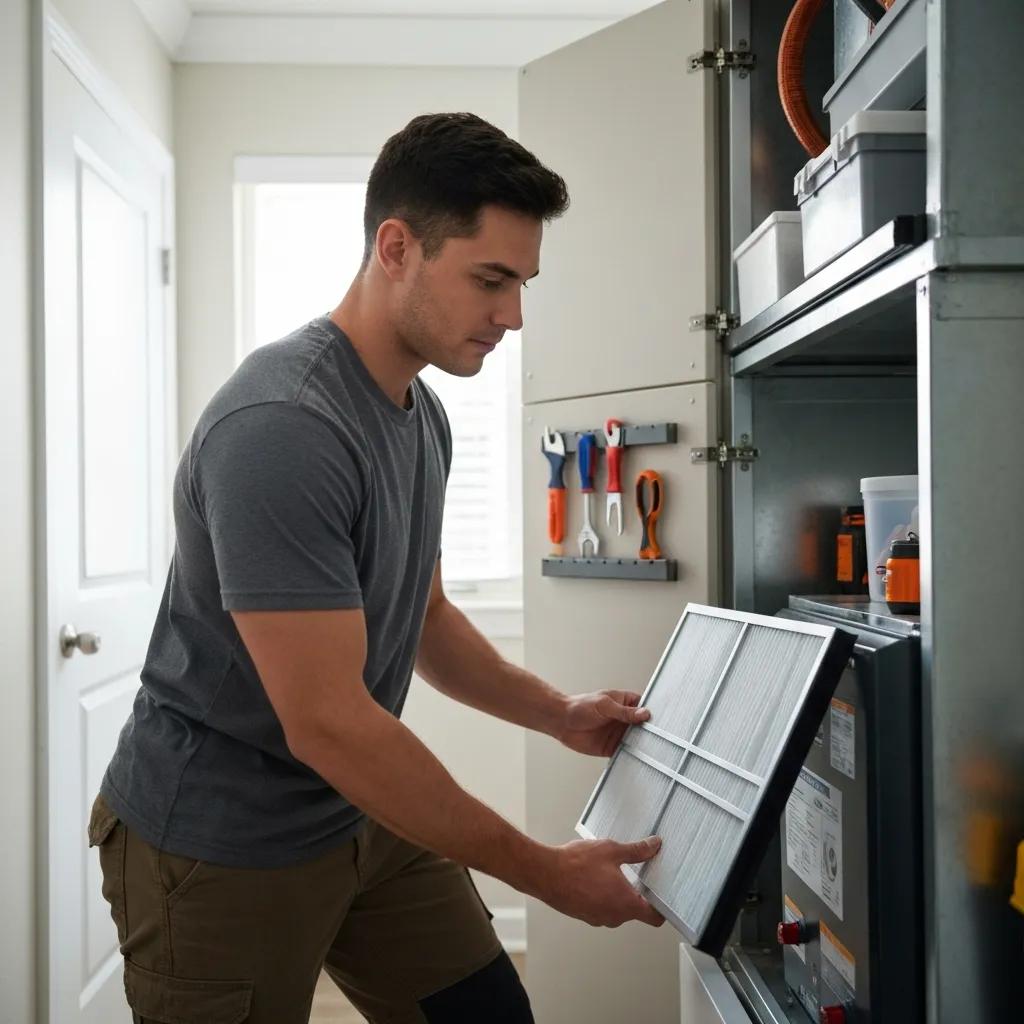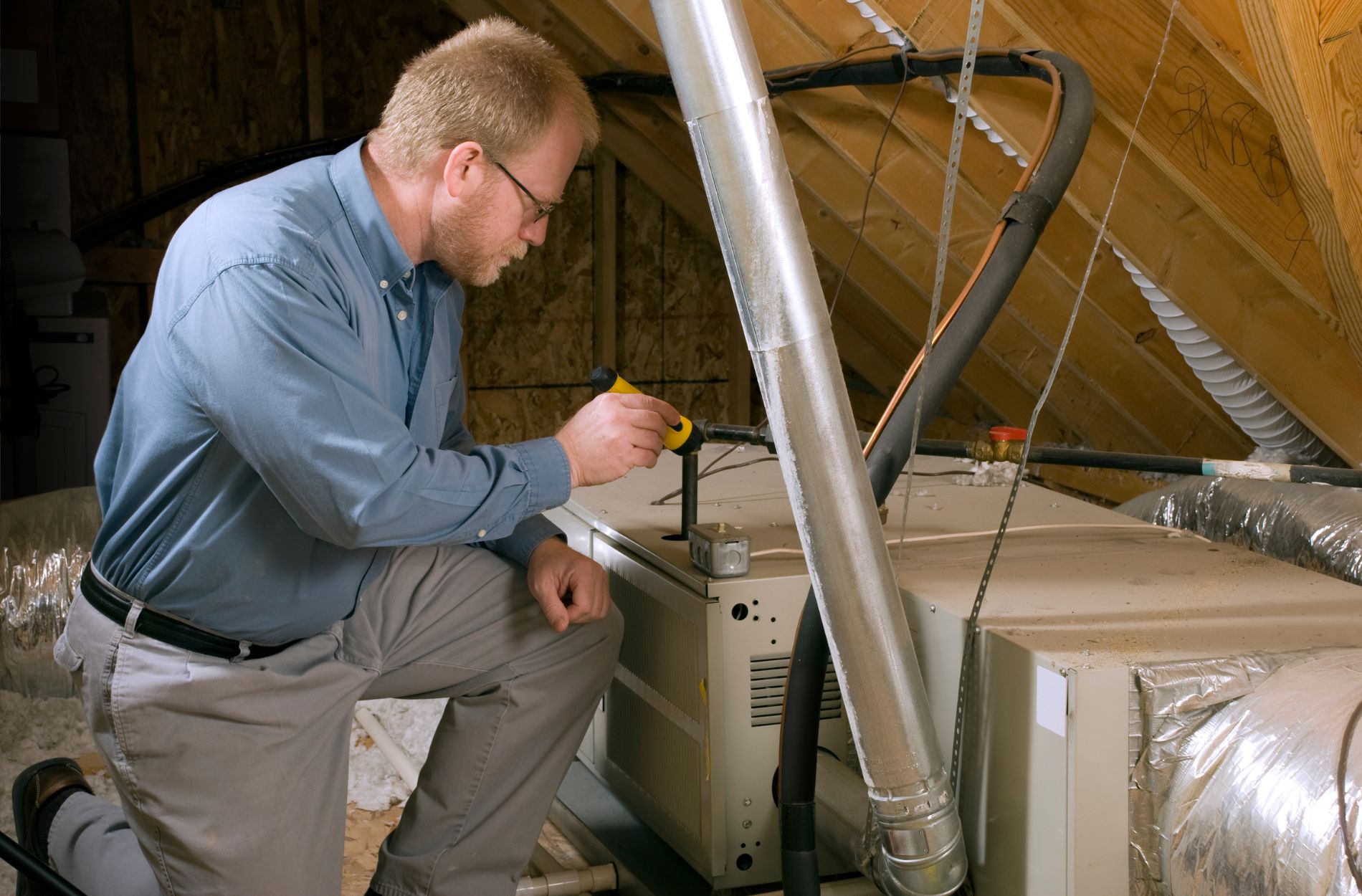
Your Complete Furnace Maintenance Guide — Practical Steps for Winston‑Salem & Mocksville Homeowners
Furnace maintenance means the routine checks, cleanings, and small adjustments that keep your home heating system running safely and efficiently. This guide explains how regular upkeep cuts energy use, lowers safety risks like carbon monoxide, and helps your unit last longer — specifically for homeowners in Winston‑Salem, Mocksville, and nearby North Carolina communities. You’ll find simple DIY tasks you can do safely, clear warning signs that need a pro, what a professional tune‑up includes, and how local costs affect your choices. We also provide a seasonal checklist and side‑by‑side comparisons to help you decide between routine care and repairs. Along the way, we explain Blown Away HVAC’s maintenance plan options and how our family‑owned team with NATE‑certified technicians can make maintenance easy and reliable.
Why regular furnace maintenance matters for homeowners
Regular maintenance is a proactive plan of inspections and service that keeps your system efficient and safe while catching small problems before they become big ones. A proper tune‑up fixes combustion issues, restores airflow, and confirms safety devices like ignition controls and carbon monoxide testing are working. That lowers operating costs, reduces safety risks, and helps preserve warranty coverage — all of which protect your wallet and your family. The sections below break down the main benefits and the warranty reasons to keep up with scheduled service.
Here are the main, measurable benefits of scheduled furnace care.
- Lower energy bills: Tune‑ups help your system run more efficiently.
- Fewer safety risks: Inspections catch combustion and CO problems early.
- Longer equipment life: Routine service reduces wear and delays replacement.
Routine maintenance shows up in real results: smaller monthly bills, fewer emergency calls, and a lower chance of premature replacement. The table below ties common tasks to the benefits you can expect.
| Maintenance Task | Benefit Type | Expected Outcome |
|---|---|---|
| Filter replacement and airflow check | Energy & IAQ | Smoother airflow — can improve efficiency by 10–20% |
| Combustion and CO testing | Safety | Finds carbon monoxide or combustion problems early |
| Burner and heat exchanger cleaning | Lifespan & performance | Reduces corrosion and heat stress; extends life |
| Thermostat calibration and airflow balancing | Comfort & energy | More even heating and shorter run times |
That comparison helps you prioritize DIY checks versus professional services so you get the best value for energy, safety, and longevity.
How maintenance improves efficiency and safety
Keeping filters, burners, and blowers clean and calibrated means your furnace reaches set temperatures faster and cycles less, which uses less fuel and causes less wear. Safety improves when a technician inspects the heat exchanger, measures combustion, and tests for CO — steps that reduce the risk of dangerous leaks. Those energy and safety wins add up to greater comfort and noticeable savings that make regular servicing worthwhile.
Next, we’ll cover how maintenance affects warranties and repair costs.
How maintenance protects warranties and lowers repair bills
Many manufacturers require proof of regular maintenance to honor parts or system warranties. A documented service visit shows you followed the manufacturer’s care guidelines, which helps preserve coverage. From a cost perspective, maintenance finds small issues — loose belts, minor ignition quirks, or dirty burners — before they turn into costly part failures. Keeping clear service records also speeds diagnostics and can reduce repair time and expense when a technician is needed.
That’s why combining safe DIY care with scheduled professional visits is a smart approach.
DIY furnace maintenance tasks homeowners can safely do

There are several non‑invasive tasks you can do at home to keep your furnace healthy, reduce service calls, and spot early warnings. These actions don’t void warranties when done correctly, and they give technicians a cleaner system to work on. Focus on replacing filters, keeping the area clear, checking vents, and confirming thermostat settings. Below we list a simple checklist and a quick reference table showing time, tools, and how often to do each task.
Simple DIY checklist to use between professional visits:
- Change air filters on the schedule recommended for your filter and household.
- Keep the furnace area clear of clutter and combustible items.
- Inspect supply vents and returns for blockages and even airflow.
- Check thermostat settings and replace batteries if needed.
These steps improve immediate performance and make the system safer to operate. Leave combustion and electrical work to certified technicians.
Quick DIY reference
| Task | Tools / Time / Safety Note | Frequency & Difficulty |
|---|---|---|
| Air filter replacement | Replacement filter, 5–15 minutes, switch power off | Monthly to quarterly; easy |
| Visual inspection of vents and area | Flashlight, 10 minutes, do not open panels | Monthly; easy |
| Thermostat battery check and calibration | Fresh batteries, 5–10 minutes | Seasonally; easy |
| Dusting around blower (external only) | Cloth, soft brush, 10–20 minutes, don’t open panels | Quarterly; use caution |
These homeowner actions deliver high value with low risk. The next section walks through changing a filter step‑by‑step.
How to change and clean your furnace filter safely
Changing the filter is the single most effective thing you can do for airflow and indoor air quality. Turn off power to the furnace, find the filter slot, note the airflow arrow, and remove the old filter gently to avoid stirring up dust. Install the correct sized replacement and choose a MERV rating that balances filtration with your system’s needs — higher MERV captures more particles but can add resistance on older blowers. Turn the power back on and check airflow and thermostat response. This usually takes 5–15 minutes and should be done monthly to quarterly depending on pets, occupants, and air quality.
Track filter changes and any performance changes — they’ll tell you when other maintenance might be helpful.
What simple checks to do around the furnace
A monthly visual and listening check will reveal many early problems. Look for rust, water, strange smells, loose panels, or pests. Make sure the floor under the furnace is dry and vents are clear. Listen for odd noises — rattles, grinding, or continuous cycling — and watch for a yellow pilot light or soot, which can signal combustion issues. If you smell gas, hear severe noises, or see abnormal flames, shut the system down and call a professional immediately. Note any observations for the technician to speed diagnosis.
These checks help you decide when to call a pro versus scheduling routine maintenance.
When to schedule professional furnace maintenance and tune‑ups
Have a technician inspect your furnace at least once a year — ideally before cold weather — and consider twice a year for older systems or heavy use. Professionals perform safety inspections, burner cleaning, and combustion testing that you shouldn’t attempt at home. A trained technician can find subtle problems like hairline cracks in a heat exchanger or control faults, and a signed service report supports warranty and resale value. The sections below list urgent signs that need immediate service and explain what a full tune‑up covers.
Professional inspections let technicians run tests and repairs that keep your home safe and the system reliable.
- Carbon monoxide alarm or gas smell — immediate service required.
- Yellow pilot light or soot — possible combustion problem.
- Frequent short‑cycling or sudden loss of heat — likely component trouble.
Scheduling a tune‑up before peak season lowers the chance of emergency calls and many maintenance programs offer priority scheduling for members.
Signs your furnace needs professional inspection or repair
Certain symptoms require a pro because they point to unsafe or failing parts. Emergency signs include CO detector activation, persistent gas smell, visible leaks, or a yellow flame. Other priority signs are frequent short‑cycling, uneven heating, grinding or banging noises, and unexplained spikes in energy bills — these usually mean mechanical wear or airflow problems. Tell your technician when symptoms started and what you noticed to help find the root cause faster.
Use these warning signs to decide between routine maintenance or urgent repair.
What a professional furnace tune‑up includes
A professional tune‑up is a step‑by‑step inspection, cleaning, calibration, and testing routine that restores safe, efficient operation. Technicians typically check safety controls, test combustion and CO levels, clean burners, verify gas pressure, and lubricate moving parts where needed. They’ll inspect the heat exchanger for signs of damage, confirm proper ignition and flame, test thermostat accuracy and balance, and measure airflow to find duct or blower issues. After the visit you’ll get documentation of findings, recommendations, and any parts replaced — useful for warranties and future planning. Regular tune‑ups reduce emergency breakdowns and give you a baseline for tracking system health over time.
Many local, family‑run companies bundle these services into membership plans that include priority scheduling and repair discounts.
How much does furnace maintenance cost in Winston‑Salem, NC?
Cost depends on the scope (inspection vs full tune‑up), furnace age and location, parts needed, and local labor rates. Older units usually need more time and parts, and hard‑to‑reach installations raise labor. Think of maintenance as an investment: the modest price of routine tune‑ups often pays back through avoided repairs, better efficiency, and extended equipment life. The table below lists common cost drivers and how they affect price.
How specific service elements typically affect price in our area.
| Service Element | Key Factors | Price Impact |
|---|---|---|
| Basic inspection/tune-up | Time on site, diagnostic tools | Low to medium |
| Parts replacement (filters, sensors) | Part cost and model compatibility | Medium |
| Major repairs (heat exchanger, motor) | Component cost and diagnostic time | High |
| Accessibility & labor | Unit location and system complexity | Medium to high |
What affects tune‑up and maintenance pricing?
Age and condition of the furnace, unit location, parts requirements, and technician certification all change service time and parts cost. Older systems often need more cleaning and hard‑to‑find parts. Tight access or multi‑level ductwork takes longer to service. Certified technicians with proper tools usually charge for expertise, but they tend to diagnose and fix issues correctly the first time. Local labor rates and seasonal demand (peak winter) also influence price; scheduling ahead of peak season can ease availability and sometimes reduce cost.
Compare these factors with your unit’s history to decide if one‑time service or a membership is the best long‑term value.
How maintenance saves money over time
Regular maintenance lowers fuel use, prevents sudden failures, and helps keep warranties valid — all of which cut long‑term costs. Clean components and correct calibration reduce runtime and wear; early fixes for small faults cost far less than major part replacements. Over a furnace’s life, the savings from fewer repairs and delayed replacement can outweigh routine service costs and improve overall reliability.
These financial benefits often influence homeowners to choose maintenance memberships, described next.
Repair vs maintenance — what's the difference?
Maintenance is preventative: scheduled inspections and adjustments to keep the system running. Repair is reactive: fixing a failed or unsafe component. Maintenance tasks like filter changes and cleaning lower the chance of breakdowns; repairs replace or restore parts after diagnostics show faults. The goal of maintenance is to preserve; the goal of repair is to restore. Knowing the difference helps you budget for preventive care that reduces costly emergency repairs.
Next we explain when repair is necessary rather than routine service.
When does a furnace need repair instead of maintenance?
Repair is needed when components fail, create unsafe conditions, or when damage is beyond what maintenance can fix — for example, a cracked heat exchanger, a burned‑out blower motor, or electrical control failures. Signs include unstable flames, significant combustion leaks, motor burnout noises, or safety devices that trip repeatedly. In those cases, stop using the system as recommended and call a qualified technician immediately to diagnose and correct the issue.
Regular maintenance helps prevent many of these costly failures, as the next section explains.
How regular maintenance prevents expensive repairs
Maintenance removes dust and buildup that cause overheating, keeps bearings and moving parts lubricated, and calibrates controls so components aren’t overworked. Finding frayed wiring or small leaks early lets a technician make inexpensive repairs before they become major. A current service history also speeds diagnostics and can reduce labor time when repairs are needed. Over time, these actions mean fewer emergency calls and a longer, more reliable system life.
That preventative logic is why many homeowners enroll in maintenance plans — see the details below.
Frequently Asked Questions
What should I do if my furnace is making strange noises?
Strange noises like banging, rattling, or grinding usually point to mechanical issues. Note when the sounds happen and what they sound like — that helps the technician diagnose faster. If the noises persist or get worse, schedule a professional inspection to prevent further damage.
How can I improve my furnace’s energy efficiency?
Start with regular maintenance: change filters, keep burners clean, and seal ductwork. Insulating your home and using a programmable thermostat also reduce energy use. If your furnace is old, upgrading to a high‑efficiency model can provide significant long‑term savings.
What are the risks of neglecting furnace maintenance?
Neglect can mean lower efficiency, higher utility bills, more breakdowns, and safety risks like carbon monoxide leaks. Regular service finds problems early and keeps your furnace operating safely and reliably.
How do I know if my furnace needs repair or replacement?
Consider repair if your unit is newer and problems are isolated. If the furnace is over about 15 years old and needs frequent repairs, replacement may be more cost‑effective. Major failures — like a cracked heat exchanger — usually mean replacement is the safer long‑term choice.
Conclusion
Regular furnace maintenance keeps your home safer, more comfortable, and more efficient. A little preventive care prevents many costly breakdowns and improves indoor air quality. Don’t wait for a problem — schedule a tune‑up before the cold sets in. Ask about our membership options for priority service, discounts, and peace of mind from Blown Away HVAC.



